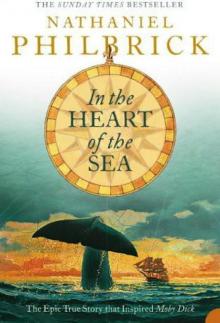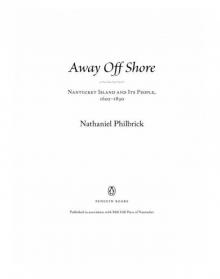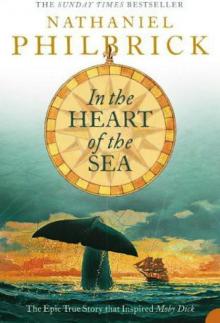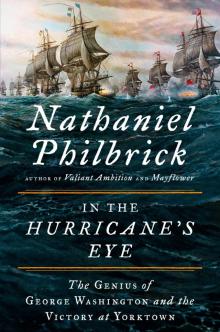- Home
- Nathaniel Philbrick
Second Wind Page 3
Second Wind Read online
Page 3
Taking a line with me, I leapt onto the bank. The mud seemed firm, and I began to pull. They were a canal boat, and I was the mule.
After a few minutes of trudging over the marsh mud, as my wife and children heckled me unmercifully, I hit quicksand. Actually, it was more like quickmud. First I sank up to my ankles, then my knees. Soon I was waist-deep in marsh muck—the rank, sulfurous scent of decay sweeping over me in eye-watering waves. Needless to say, the crowd on board the Beetle went wild.
But I was too distracted to notice. Through a break in the marsh grass I could see the distant saltwater pond that marked the end of the Creeks. Compared to the burbling, mud-fringed frenzy of this tidal stream, that distant pond exuded a sun-dappled sense of absolute serenity. It looked very much like the nearly windless puddles that Mom and Dad had so cheerfully sailed, beckoning my brother and me to join them. Then it hit me.
I would sail the Nantucket equivalent of the man-made, midwestern lakes of my boyhood. I would sail the ponds. There are close to twenty of them on the island; some of them are relatively large, some are microscopic, but almost all would be sailable in a Sunfish. Part Joshua Slocum, part Thoreau, I would voyage from pond to pond until I arrived at my final destination—the Sunfish North Americans.
In a Bog
IT WAS COLUMBUS DAY WEEKEND. Five hundred years since that legendary sailor had first laid eyes on an island in the Caribbean, my own island was to be the site of a more personal voyage of exploration. There was one hitch, however. Over the summer the English ivy that flourishes around the foundation of our 150-year-old house had wormed its roots into the aluminum lip of my Sunfish’s gunwale. When it came time to put the boat onto the car roof, I literally had to tear it away from the house. Hunks of dirt were caked along the lower edge of the boat. Dispossessed potato bugs ran screaming for cover. In the Sunfish’s cockpit a reddish-brown soup of rainwater, leaves, and what looked like the ancient remains of some kind of food proved that life may have indeed evolved from the ooze. Wedged between the boat and the ivy-covered house was my badly mildewed spar bag. I didn’t even want to think about what the sail inside looked like. Melissa and Jennie were scheduled to be “off island” (a Nantucketer’s version of “out of town”) that weekend with another mother and daughter doing some heavy female bonding in Boston. That left Ethan and me on our own, and Ethan was about three feet too short when it came to helping me get the 135-pound Sunfish on and off the car roof.
Then my old college roommate Marc called up to ask if he and his new girlfriend could come to the island for a quick visit. Now I had all the brawn I needed, and on Sunday morning, with the grimy Sunfish strapped to the roof and with Ethan, Marc, his girlfriend Beth, and our dog Molly all crammed into our Colt Vista, I set out in search of my first pond to conquer.
Since downtown Nantucket and the waterfront were still crowded with tourists, I thought it best to make a tactical retreat to the Moors, one of the island’s more inaccessible areas. This gently rolling landscape is graphic evidence of Nantucket’s glacial origins. Known technically as a knob and kettle landform, the Moors originally came into being when large chunks of ice became mixed up with the sand and gravel deposited by the melting glacier more than fifteen thousand years ago. When the buried ice chunks melted, deep hollows (or kettles) were formed, creating a wavelike terrain dotted with small ponds.
A hundred years ago, sheep kept almost the entire island closely cropped. Since then much of Nantucket has become overgrown with either trees or houses, but these Moors, officially known as a heathland, have remained, for the most part, much as they once were. A network of dirt roads crisscrosses its undulations. As you drive up and down the hills, it’s easy to lose your bearings, and it wasn’t long before I hadn’t a clue where we were.
Marc, who has never been one to keep his thoughts to himself, wondered how there could possibly be a pond in a place that looked so much like the surface of the moon. Ethan complained that all the up-and-down motion was making him carsick. Way in the backseat, jammed among my rudder, lifejacket, and other sailing paraphernalia, Molly the dog was clearly not happy.
It was Beth who spotted it first.
“Look! Water!”
There was Gibbs Pond, a quarter-mile circle of blue. Just beyond it was the deep red of the Windswept Cranberry Bog, the largest natural bog in the world. Harvesting had just begun.
In the seventies Gibbs Pond had been the site of an annual Thanksgiving Sunfish regatta. With the class in its heyday, up to twenty island boats would attend. Now I was the sole keeper of the faith. In any event, it was as good a place as any to begin my training program.
Unfortunately, there wasn’t much wind. An almost preternatural stillness reigned, marred only by the distant drone of the cranberry pickers’ machinery. Marc helped me lift the boat off the roof and carry it down a narrow path to the water’s edge. Beth and Ethan threw sticks for Molly as I scrubbed the deck. With a final pause, I sponged away the grease pencil marks, the last clues, perhaps, to an earlier self.
But if the hull was now a blank slate, the sail was another matter. All those years in the spar bag had created a giant Rorschach test of mildew, a bloated amoeba of filth that seemed about to ingest the much smaller Sunfish insignia. My racing steed was an embarrassing mess.
I pushed off for a solo spin around the pond, but I was finding it next to impossible to concentrate on sailing. For one thing, there was barely enough wind to fill my sail. For another, there was all this natural beauty. Within the hollow of these autumn-tinged hills I was inching across a trembling mirror of blue, brown, red, yellow, and green. I was also floating on the lid of a time capsule—a receptacle filled with ancient glacial runoff and the accumulated stones, bones, and artifacts of ten thousand years of human habitation.
In what I remembered as my prime, I had sometimes found myself in a kind of mental tunnel, a narrow corridor of absolute concentration that I used to call the Zone. All sports have it—a point at which what once seemed so difficult and complex becomes, at least for a time, astonishingly simple, a matter of instinct. Along with this Zen-like sense of certainty, the Zone has a more ruthless side, a very un-Zen-like competitiveness—a need to win. Did I care enough anymore to fight my way back into the Zone?
I thought of Ferdinand, a character from a children’s story I had read repeatedly to Jennie and Ethan. Ferdinand isn’t like other young bulls; instead of wanting to fight and strut his stuff at the bullfights in Madrid, he wants to remain in his pasture, sitting quietly in the shade of a cork tree and smelling flowers. Now I wondered whether I could both sniff the flowers and rouse myself to gore the matador. Given that there wasn’t any wind, sniffing the flowers looked like my only option.
I beached the boat and invited Ethan, Marc, Beth, and even Molly to come aboard. Skeptically, they all squeezed under the low-slung, race-rigged boom, and we headed to the far side of the pond to watch the cranberry harvesters. It’s hard to fit that many people and a dog on a Sunfish. I stood on the stern holding the tiller. Ethan stood on the bow and held on to the spars while Marc and Beth sat with their feet in the cockpit. Molly cowered near the splash rail, desperate to have it over with.
We landed beside an old pump house used to adjust the water level of the bogs. For most of the year the bogs are relatively dry, but during harvest season they are flooded and threshed with a machine that looks like a combine on stilts, and the berries all float to the surface. Just as we arrived, the workers were collecting the berries into a huge blanket of brilliant red that they then fed to a conveyor belt that carried the berries to an awaiting dump truck.
As we sailed back, fog began to appear along the edges of the pond. By the time we were once again in the car, the road was showing dimly through the mist.
The wipers slapped across the windshield, and I strained to see what loomed ahead. Marc asked, “You going to do this all winter?”
“That’s the
plan,” I said.
“What exactly is the plan?”
“A pond a week. I figure there’s at least a winter’s worth of them, all different shapes and sizes.”
“You’ll be sailing even in February?”
“That’s the plan.”
We drove on in silence. After a while, he said, “Think you’ll win it again?”
“Well, it doesn’t look so good right now.”
Marc turned and looked out his side window into the fog. “No, it doesn’t.”
If today’s sail hadn’t moved me much closer to becoming a competitive Sunfish racer, I still had faith. And the only way to proceed was one pond at a time.
The Green Gush
AT DINNERTIME ON FRIDAY of the next week, the phone rang. It was a long-distance call for Melissa. Being a small-town lawyer, she gets more than her share of business calls at dinnertime. But Nantucket isn’t an ordinary small town. Now that the island has made the transition from a world-renowned whaling port to an equally famous summer resort, it is still globally connected.
A client was calling from Hong Kong, where the sun was rising to a new morning. On Nantucket he owns a large house situated on a narrow bluff between Sesachacha (pronounced SACK ah cha), one of the bigger ponds on the island, and the Atlantic Ocean. In recent years the pond, and Melissa’s client, had been in the midst of a controversy. For hundreds of years the town had been “opening” the pond to the sea on a biannual basis, a flushing process inherited from the Indians. Besides allowing for the migration of herring, the opening also helped control the growth of algae and weeds in the pond. Then, about a decade ago, the state environmental people stepped in and called a halt to this ancient practice. Soon the pond became choked with weeds; billions of midges began to buzz over the water; the pond started to die.
Finally, after a local vigilante went to jail for digging a trench with a shovel and opening the pond himself, the state relented and allowed the town to resume its old ways. Melissa’s client owned the land where the trench was traditionally dug and had inevitably become involved in the controversy. Now that everything was legal, he only wanted to be sure that the beach was put back together after the pond had been opened.
Melissa’s client had just received a fax informing him that the town planned to open the pond (with as little fanfare as possible) the next morning. A strong southwesterly breeze was forecast, the direction needed to help blow the water out of the pond and keep the trench open as long as possible before ocean currents eventually closed it. Could Melissa please contact the selectmen and make sure all was being done according to the standing agreement?
My training program suddenly gained a new dynamic. I would sail Sesachacha. I remembered hearing stories about the shovel-wielding vigilante getting blown out to sea by the sudden rush of water he unleashed. Through a massive gash in the sand I would boldly sail where no man had sailed before. The next day there was a near gale blowing from the southwest, a weirdly balmy breeze for mid-October. Autumn leaves clattered across the street all morning, but it wasn’t until 1:30 in the afternoon that I was able to head out for the pond.
Melissa did not want me to go. She saw the cut across the beach as a kind of bathtub drain, an inexorable suck to oblivion. I preferred to view it in more positive terms: a birthlike gush into the blue salt sea.
Also, Melissa wasn’t thrilled about following me all the way out to the east end of the island, helping me off-load the boat, then returning a couple of hours later to put it back on the car roof. Indeed, the prospect of doing this every weekend for the next nine months was not making her very happy. But at least Nantucket was an island less than fourteen miles long, and Sesachacha was about as far away from our house as it was possible to get.
After loading the boat onto the ten-year-old Chevrolet Citation that served as our second car, Melissa followed me in the Vista. The Citation was the quintessential “island car,” a vehicle that you wouldn’t dare drive anywhere but on Nantucket. The kids called it “the Stinker” because it was the car in which we took the garbage to the town dump. About three months earlier the car had lost second and fourth gear, and not wanting to put any more money into it than I had to, I’d been getting along fine with just two forward gears. Sure, it rumbled a little bit in the transition from first to third, and you couldn’t go much more than forty miles an hour, but when did you ever need to go any faster on Nantucket?
I half expected to find the pond sucked almost dry, but all seemed relatively normal as Melissa and I lugged the boat down to the water’s edge. The kids were at the high school pool watching a swim meet, so it was just the two of us. On the opposite side of the pond we could see a backhoe surrounded by about half a dozen pickup trucks. A cut had obviously been made in the pond side of the beach, and yet there was no swirling rush of water cresting around the opening. All looked static, even serene.
Melissa waited until I had pulled up the sail. Even though we were sheltered by a clump of trees, the sail flapped like a flag in a hurricane; it was really blowing.
“This is crazy,” Melissa said.
“I know,” I said, zipping up my lifejacket.
“It’s dangerous.”
“This is a pond. Even if my mast breaks, I can walk back to the car.”
“But what about the opening?”
“I’ll keep clear of it, I promise.”
“Remember,” Melissa said as she turned to go, “you have two children.” A particularly strong puff came through. Melissa said something else, but I couldn’t hear her over the flogging sail.
With the rudder down and the daggerboard halfway in, I jumped onto the boat, gave the sail a few tugs with the mainsheet, and was off on a run. The boat immediately leapt onto a blinding plane, the kind of plane in which the boat wobbles side to side like an X-15 rocket plane about to burst through the sound barrier. If I remembered correctly, it really had to be blowing for a Sunfish to behave like this on a run. And the farther I got from the windward shore, the more the wind increased. By the time I was in the middle of the pond, I was holding on for dear life. And up ahead, spread wide like the gaping jaws of a huge beast, was the cut.
Before I got any closer to the cut, I decided that I better round up and test the breeze more carefully. As soon as I did, I was socked with what must have been a thirty-five-knot puff. As I bore back down, the boat took off onto a full-tilt plane, spray flying in all directions. Soon I was zooming past the cut. There was no evidence of any current running out into the ocean.
Then with a puff of smoke from its exhaust pipe, the backhoe began to lumber toward the ocean side of the beach. So that was it—the opening had not yet been completed. This was something I had to see. I decided to park the boat near the cut and watch the show.
The breeze was so strong that a mountain of frothy pond scum had accumulated on the shore. I hauled the Sunfish through the brown foam onto the beach. It was a long trudge through the ankle-deep sand to where they were digging. The people assembled there (a few civic types and some fishermen) looked at me as if I had just arrived from the planet Mars, and that’s exactly how I felt, standing there in my soaking wet sailing coveralls and lifejacket.
“Nat!”
I turned and saw Laura, a friend and member of the Conservation Commission. She had a surfcasting rod in her hand. “I had no idea it was you until I read your name on the back of your lifejacket.”
Laura explained that they’d been waiting for the tide to go out all the way so as to maximize the difference between pond and sea levels. Now it was dead low and time to finish the cut. As the backhoe moved up and down the trench, widening and deepening it, the water gradually increased to the point that it finally burst through in a green rush that quickly carved out a twenty-foot-wide opening. Minnows leaped in the flow as some of the fishermen began casting out into the ocean in the hope that these minnows would act as bait for bluefish and
sea bass. The backhoe driver gunned his engine and roared away just in time to avoid having his rear wheels undermined by the flowing water.
It soon became obvious that, even if I had wanted to, there was no way I was ever going to sail through the cut. It was too narrow and its banks were too steep to accommodate a Sunfish with its boom all the way out. Perhaps it was just as well.
Saying good-bye to Laura, I headed toward my boat. The hull was now almost completely buried beneath the scum. Clearing it away as best I could with my hands (it felt like a mixture of Cool Whip and marsh mud), I pulled the boat out into the water. I now had two hours of heavy-air sailing ahead of me within the confines of a small but big enough pond. It was just the kind of practice session I was looking for.
When the wind is strong, the sail generates more lift than the boat knows what to do with, causing the boat to tip, or heel. To keep the boat from capsizing, a sailor “hikes out” by leaning out as far as possible on the side opposite the sail and using his or her body weight to keep the boat from heeling. If the force of the wind is so strong that the boat continues to heel even though the sailor is hiked out all the way, it’s time to reduce the pressure on the sail by letting a portion of it flap, or luff. This is accomplished in one of two ways—easing the mainsheet or using the rudder to turn the boat in the direction of the wind. When it’s blowing hard, a sailor spends most of the race hiked out while constantly adjusting the mainsheet and rudder to keep just the right amount of drive in the sail. It can be exhausting work, particularly over the course of an entire day of racing.
Whether or not the people on the beach had anything to do with it, I don’t know, but I began my upwind beat like a hotdogging kid, grimacing heroically as I pumped the sail and rocked my upper body in the puffs. Two minutes into this shameless display of muscles I didn’t have, however, my body caught up with me. Soon I was hunched over on the deck, trying to catch my breath, and I wasn’t even a quarter of the way up the pond.

 Bunker Hill: A City, a Siege, a Revolution
Bunker Hill: A City, a Siege, a Revolution Why Read Moby-Dick?
Why Read Moby-Dick? Second Wind: A Nantucket Sailor's Odyssey
Second Wind: A Nantucket Sailor's Odyssey The Last Stand: Custer, Sitting Bull, and the Battle of the Little Bighorn
The Last Stand: Custer, Sitting Bull, and the Battle of the Little Bighorn In the Heart of the Sea: The Epic True Story That Inspired Moby-Dick
In the Heart of the Sea: The Epic True Story That Inspired Moby-Dick Away Off Shore: Nantucket Island and Its People, 1602-1890
Away Off Shore: Nantucket Island and Its People, 1602-1890 The Mayflower and the Pilgrims' New World
The Mayflower and the Pilgrims' New World The Last Stand: Custer, Sitting Bull and the Battle of the Little Big Horn
The Last Stand: Custer, Sitting Bull and the Battle of the Little Big Horn Second Wind
Second Wind Away Off Shore
Away Off Shore The Mayflower and the Pilgrims' New World*
The Mayflower and the Pilgrims' New World* Sea of Glory
Sea of Glory In the Heart of the Sea
In the Heart of the Sea The Last Stand
The Last Stand In the Hurricane's Eye
In the Hurricane's Eye